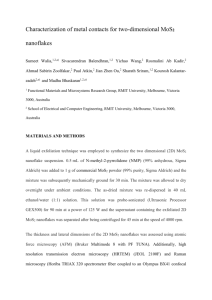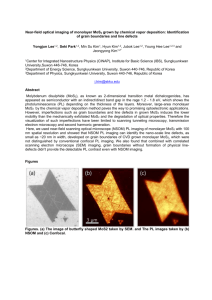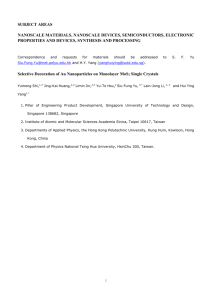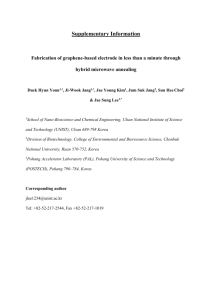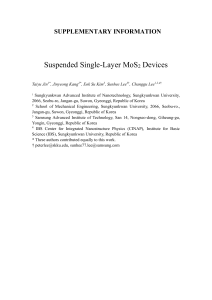Electronic transport and device prospects of monolayer deposition
advertisement
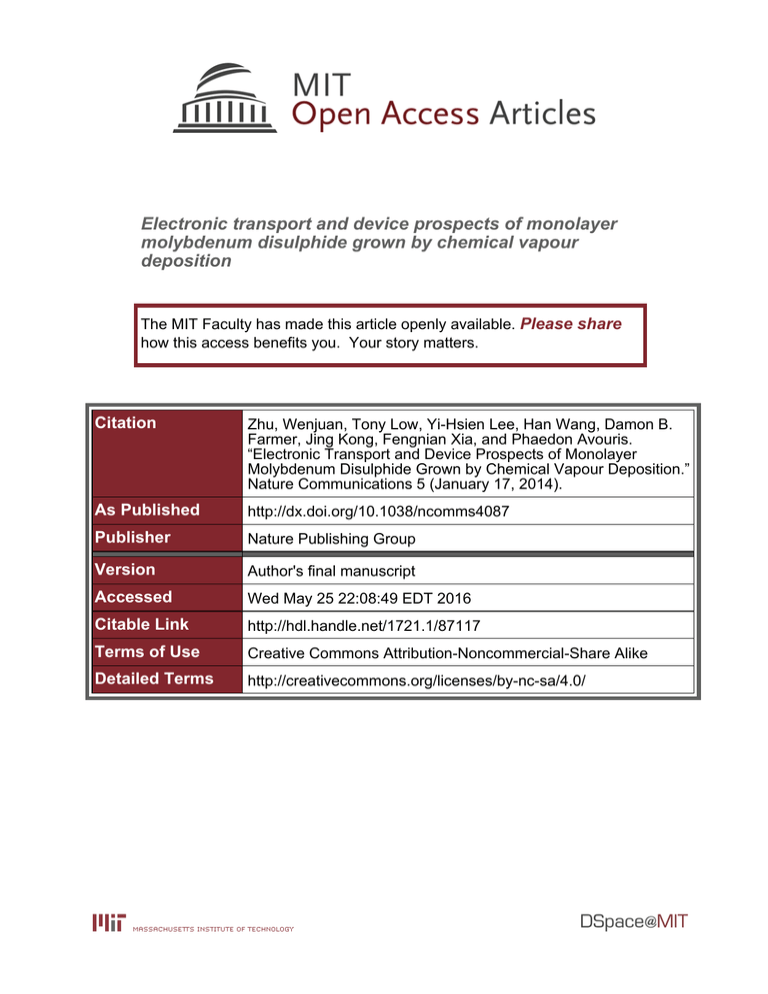
Electronic transport and device prospects of monolayer
molybdenum disulphide grown by chemical vapour
deposition
The MIT Faculty has made this article openly available. Please share
how this access benefits you. Your story matters.
Citation
Zhu, Wenjuan, Tony Low, Yi-Hsien Lee, Han Wang, Damon B.
Farmer, Jing Kong, Fengnian Xia, and Phaedon Avouris.
“Electronic Transport and Device Prospects of Monolayer
Molybdenum Disulphide Grown by Chemical Vapour Deposition.”
Nature Communications 5 (January 17, 2014).
As Published
http://dx.doi.org/10.1038/ncomms4087
Publisher
Nature Publishing Group
Version
Author's final manuscript
Accessed
Wed May 25 22:08:49 EDT 2016
Citable Link
http://hdl.handle.net/1721.1/87117
Terms of Use
Creative Commons Attribution-Noncommercial-Share Alike
Detailed Terms
http://creativecommons.org/licenses/by-nc-sa/4.0/
Electronic transport and device prospects of monolayer molybdenum
disulphide grown by chemical vapor deposition
Wenjuan Zhu1*†, Tony Low1*, Yi-Hsien Lee2, Han Wang1, Damon B. Farmer1, Jing Kong3,
Fengnian Xia4 and Phaedon Avouris1
1
IBM Thomas J. Watson Research Center, Yorktown heights, NY 10598, USA
2
3
4
National Tsing Hua University, Hsinchu, 30013, Taiwan
Massachusetts Institute of Technology, Boston, MA 02139, USA
Department of Electrical Engineering, Yale University, New Haven, CT 06511, USA
Layered transition metal dichalcogenides display a wide range of attractive physical and
chemical properties and are potentially important for various device applications. Here
we report the electronic transport and device properties of monolayer molybdenum
disulphide (MoS2) grown by chemical vapor deposition (CVD). We show that these
devices have the potential to suppress short channel effects and have high critical
breakdown electric field. However, our study reveals that the electronic properties of
these devices are at present, severely limited by the presence of a significant amount of
band tail trapping states. Through capacitance and ac conductance measurements, we
systematically quantify the density-of-states and response time of these states. Due to the
large amount of trapped charges, the measured effective mobility also leads to a large
underestimation of the true band mobility and the potential of the material. Continual
engineering efforts on improving the sample quality are needed for its potential
applications.
*
These authors contributed equally to the work.
Emails are: W.Z (wenjuan@us.ibm.com), F. X. (fengnian.xia@yale.edu), and P. A.
(avouris@us.ibm.com).
†
1
Introduction
Two-dimensional materials are attracting considerable attention due to their unique
electronic, optical, and mechanical properties1. Following the success of graphene, a
group of 2D materials known as the transition metal dichalcogenides (TMD) has begun to
garner attention. Among them, molybdenum disulfide (MoS2) is probably one of the most
explored TMDs 2,3. The sizeable (1.8 eV) direct bandgap of monolayer MoS2 4 makes it a
potential material for not only digital electronics, but numerous photonic applications
such as light emitter5, photodetectors6,7, and solar cells 8. Excellent mechanical flexibility
of MoS2 also makes it a compelling semiconducting material for flexible electronics9,10.
Most existing studies and device demonstrations were performed on exfoliated MoS2
flakes
11-19
. In particular, field-effect-transistors based on monolayer MoS2 was found to
exhibit high on/off ratios of ~108, steep subthreshold swing of ~70 mV/dec
18,20
reported electron effective mobility ranging from 1 cm2/Vs to 480 cm2/Vs
, with
14,17,20-26
depending on the device structures, dielectric environment and processing21,27. These
encouraging early reports coupled with continual engineering efforts
28
, present a
compelling case for monolayer MoS2 as an alternative to traditional organic material or
amorphous silicon for low-end applications with basic requirement of an effective
mobility of > 30 cm2/Vs 20 e.g. high resolution displays and photodetection 6,7.
Recently, the advent of mass production technologies has enabled scalable growth of
polycrystalline monolayer MoS2 by chemical vapor deposition (CVD)
29-32
, hence
providing a commercially viable path towards MoS2 electronics at low cost 33. However,
the mobility of CVD MoS2 is typically much lower than its exfoliated counterpart, with
2
reported values in the range of 5 to 22 cm2/Vs 34-36. The physical origin of the differences
between CVD and exfoliated MoS2 are not clear at present, however, structural defects 37
such as vacancies, dislocations, grain boundaries as well as charged interfacial states due
to the dielectrics in contact
14
can be responsible for the degradation in mobility.
Although this problem has presented a major hurdle to the realization of wafer-scale
MoS2 electronics and photonics, systematic studies of it are very few35. Very recently,
the MoS2 community realized that there technical difficulties to accurate mobility
extraction, due to the role of contacts and fringing capacitive contributions
38
. Four-
terminal Hall effect measurements are more accurate, but have only been demonstrated at
very high carrier densities using a electrolyte gating scheme
temperatures
17
26
, or at very low
. These Hall measurements were all performed on exfoliated MoS2, and
will be more challenging to perform in CVD samples due to significantly larger amount
of localized states, as will be discussed in this manuscript.
In this paper, we present a systematic methodology for characterizing electronic
properties of scalable CVD MoS2, reporting also the presence of significant amounts of
band tail states and their profound impact on the electrical device performance. The
density distribution and dynamics of these trap states of CVD MoS2 are characterized
through systematic capacitance and ac conductance measurements. Extraction of basic
electronic transport quantities like the mobility edge and effective mobility are performed
using four-probe current measurements. Complementary modeling allows us to draw
insights into relevant device quantities such as the fractional occupation of band and trap
states, band mobility and the anomalous sub-threshold slope. Lastly, high field electrical
3
behavior such as drain-induced barrier lowering and critical breakdown fields are
examined.
Results
Characterization of monolayer CVD MoS2
Monolayer MoS2 were synthesized by CVD, using solid sulfur (S) and molybdenum
oxide (MoO3) as the precursors and perylene-3,4,9,10-tetracarboxylic acid tetrapotassium salt (PTAS) 39 as the seed for the CVD growth (see Methods for details). Hallbar devices were fabricated on these CVD MoS2 mono-layers. Fig. 1a illustrated the
schematic of the device. The top gate dielectrics are 2nm aluminum deposited by e-beam
evaporation and re-oxidized as a seed layer, followed by 30nm HfO2 deposited by atomic
layer deposition (ALD). The details of the device process are discussed in Methods. The
atomic force microscopy (AFM) image and the step height profile at the boundary of a
MoS2 triangular area are shown in Fig. 1b and the inset of Fig. 1b, respectively. The
thickness of the MoS2 layer is measured to be about 0.8 nm, confirming its monolayer
character. The Raman spectrum of the CVD MoS2 is shown in supplementary Fig. S1.
The E2g and A1g modes are at around 383 and 403 cm-1, respectively. Comparing the peak
position to the spectrum obtained from the exfoliated monolayer MoS2 40, we further
verify that the MoS2 film is monolayer.
Density and dynamics of band tail states
At present, the reported values of the electron mobility in CVD-grown MoS2 devices 34-36
are at least two orders of magnitude smaller than the intrinsic limit 41, suggesting a high
degree of disorder and scattering. An inhomogeneous potential distribution in a
4
semiconductor leads to the smearing of the band-edge and the formation of a tail of bandgap state 42. For example, this inhomogeneity could be the result of a random distribution
of trapped charges in sulfur vacancies in MoS2 itself
43
, or at MoS2–dielectric (SiO2 or
high-k dielectric) interfaces 14. Structural defects 37, e.g. simple vacancies 43, dislocations
and grain boundaries would also lead to localized gap states.
The electronic states in the band tail can be characterized using standard capacitance and
ac conductance measurement commonly used in the study of semiconductor devices
44
.
Here, these localized states respond like traps with different time constants it , and are
electrically equivalent to an additional capacitance and resistance in parallel to the
semiconductor capacitance. The gate-to-channel capacitance and resistance were
measured on the Hall-bars, with high terminal on the top gate and low terminal on the
source, drain and all four voltage probing leads simultaneously, as shown in
supplementary Fig. S2. The measured capacitance as a function of frequency is shown in
Fig. 2a. The observed double hump feature indicates at least two types of traps with
different time constants at a given gate voltage. Herein, we denote these traps by the
labels “M” and “B”, for reasons which will be made apparent below. The equivalent
circuit model of the device is shown in Fig. 2b with total impedance given by:
Z (YitB YitM iCs iC j ) 1 (iCox ) 1 rs
(1)
where is the angular frequency, Cs is the quantum capacitance of the MoS2, Cj is the
parasitic capacitance, Cox is the oxide capacitance, rs is the series resistance, YitM and YitB
are the traps’ admittance. Here YitB [ itB CitB 1/(iCitB )]1 , where CitB and itB are the
capacitance and time constant of trap B. The trap capacitance CitB is related to the trap
5
density DitB via: CitB eDitB ,where e is the elementary electric charge. Similar
expressions apply to trap M. The measured capacitance in series mode Cms is related to
the imaginary part of the total impedance Z by:
Cms
1
* Im[ Z ]
(2).
The lines in Fig. 2a are the fits using this model. We can see that the model provides an
excellent fit to the experimental data. From the fitting, we can extract the density of traps
and their time constant as a function of gate voltage, shown in Fig. 2c. Here, we observe
that traps “M” and “B” are populated predominately within the “mid-gap” and “bandedge” regions, respectively.
Alternatively, the density and time constant of the traps can be extracted from the ac
conductance G p 44. The ac conductance is obtained from the measured capacitance and
resistance. The measured resistances as a function of gate voltage at various frequencies
are shown in supplementary Fig. S3. The extraction method of ac conductance are
described in more detail in the Supplementary Note 1. The extracted ac conductance over
angular frequency G p is plotted as function of the driving frequencies f in Fig. 2d.
Since the density-of-states of type B traps is several orders of magnitude larger than that
of type M in this gate bias range, we expect the former to dominate the ac conductance.
The relation between G p ( ) and the trap density DitB is given as 44:
G p ( )
eDitB
ln[1 ( itB ) 2 ]
2 itB
(3)
6
from which one can deduce the DitB and the respective time constant itB from the
following simple relations 44:
DitB
itB
2.5 G p
e peak
(4)
1.98
2 3.14 f 0
(5)
Here, (G p ) peak is the maximum G p value, and f 0 is the frequency at which
this maximum is obtained. Repeating the above procedure for different top gate voltages
VTG , allows us to extract DitB (VTG ) and itB (VTG ) as shown in Fig. 2c. From Fig. 2c, we
see that the density-of-states and time constant of B type traps extracted based on the
capacitance and ac conductance are in good agreement.
Below, we present parameterized models for the electronic density-of-states and their
time constants fitted to the experiments. We describe the electronic density-of-states of
the measured distributed trap states at the band-edge (i.e. type B) and the extended states
with two piece-wise functions as follows:
E ED
D0 exp
DitM
Dn E
D (1 ) D exp E ED D
itM
0
0
'
, ED 12 EG E ED
(6)
,
E ED
and illustrate them in Fig. 2c and 2e. Here, D0 is the 2D density-of-states for perfect
crystalline MoS2, taken to be 3.31014 eV-1cm-2 , consistent with an effective mass of
0.4 m0 at the conduction band minimum at the K valley for monolayer MoS2 45. Here we
ignored contribution from the satellite valley along K with energy 200meV higher than
7
the conduction band minimum 41,46, because the carrier population is insignificant at these
energies at our biasing range. Furthermore, our MoS2 devices are typically n-type doped.
is the characteristic energy width of the band tail. In the limit of 0 , Dn ( E )
becomes a step function as required for perfect 2D crystals with the conduction band
edge situated at ED . ' is chosen so that the two piece-wise functions have continuous
gradients at ED . Solving the electrostatics problem, to be described below, a best-fit to
the
experimentally
extracted
density-of-states
yields
the
parameter
set:
0.33 and 100meV . The comparison between the model Dn (VTG ) and the measured
band tail states DitB (VTG ) is shown in Fig. 2c, and the mid-gap states DitM (VTG ) is
described by an error function instead. The traps’ response time are fitted to an
exponential model,
E Emid
0 exp
(7)
and the comparison with experimental data is shown in Fig. 2c.
With the parameterized density-of-states model, we can calculate the ac capacitance and
compare against experiments. The Poisson equation describing the electrostatics of the
problem can be expressed as:
V ED / e
Qn Q0 ox TG
ttop
(8)
where ttop is the "effective-oxide-thickness" for the top gate dielectric, ox is the dielectric
constant of silicon oxide, Q0 is a constant which includes contributions from the fixed
8
charges and doping in as-prepared MoS2 etc, and Qn is the electronic charges in the
smeared
out
conduction
band
and
can
be
computed
from
Qn e Dn ( E ) f n ( E , EF )dE where f n is the Fermi Dirac function. In solving for the selfconsistent electrostatics described by Eq. 8, the Fermi energy EF is taken to be the
reference i.e. EF 0 . Once the electrostatics is determined, the admittance associated
with each of the traps can then be computed via,
Yit e 2 Dit
j 2 it f n
dE
2
1 it E
(9)
and the total capacitance can be computed employing the equivalent circuit model in Fig.
2b, and using equation (1) and (2). Reasonable agreement with the measured ac
capacitance is obtained as shown in Fig. 2f.
To summarize, the electronic density-of-states model described above is well-calibrated
to the experimentally measured density and dynamics of the band tail states. It follows an
exponentially decaying behavior, with a significantly large energy width of 100meV ,
suggesting a high degree of potential disorder and scattering. This model will be
employed in the subsequent discussion to obtain other quantities of interest, such as the
band mobility.
Mobility edge
The concept of a "mobility edge" has greatly facilitated our understanding of electronic
transport in a disordered system 47. The mobility edge is a boundary located in the band
tail, in which states above it are extended states with band transport, while those below it
9
are localized states that conduct via thermally assisted mechanisms such as Mott variable
range hopping (VRH) 48-50 or an Arrhenius-type activated behavior 51. Four point variable
temperature measurements were performed on our devices from 4.4 to 400 K as shown in
Fig. 3a. We found that neither the VRH nor the Arrhenius model can individually
describe the data satisfactorily over the whole temperature range. It is very likely that a
combination of both transport mechanisms might be operating here. For example, the
VRH usually dominates for localized states deep in the band tail, while the Arrheniustype activated behavior is more likely for shallow localized states.
The conductance versus the inverse of temperature ( 1 T ) is shown in Fig. 3b, showing
the exponential decrease with 1 T over the intermediate temperature range, where the
conductance G can be described by:
G G0 e Ea / k BT
(10)
where Ea is the activation energy, k B is the Boltzmann constant and G0 is a fitting
parameter. This allows us to extract the activation energy Ea E M EF . The measured
Ea (versus VTG ) is compared to the model (see Fig 3b inset), which allows us to
determine the location of the mobility edge EM in the energy band picture. We found
that in our devices EM is 0.01eV above ED , as illustrated in Fig. 2e. We also noticed a
departure from activated behavior at lower temperature or bias, indicating the possible
onset of an additional transport mechanism such as VRH. The extracted activation energy
in the inset of Fig. 3b suggests that in most of our gate biases, the Fermi level does not
exceed the mobility edge energy. However, at large VTG i.e. VTG 2V , the Fermi energy
10
is within tens of meV from the mobility edge. Hence, one can expect an appreciable
fraction of extended states occupation due to thermal smearing. The calculated band
carrier density as a function of gate voltage at various temperatures are shown in Fig. 3c.
Transport coefficients
The “effective mobility”, or sometimes referred to as the “drift mobility”, is a commonly
used transport coefficient in semiconductors 52. It is defined as the ratio of the measured
conductivity to the total charge density i.e. eff Qtotal . The total charge density
Qtotal is typically estimated from Cox (Vg VT ) , where Cox is the oxide capacitance, Vg is
the gate voltage, and VT is the threshold voltage. We extract Cox from the measured
capacitance at strong accumulation. Fig. 4a shows the effective mobility as a function of
gate voltage at different temperatures. The effective mobility is <10 cm2/V-s over the
range of temperature and applied bias in our experiments. Contact resistance is
eliminated in our measurement which employs a four-probe scheme. The measured
effective mobility is significantly lower than the phonon-limited intrinsic mobility in
monolayer MoS2, predicted to be over 400 cm2/V-s 41, and the highest measured mobility
of ~200 cm2/V-s in exfoliated MoS2 devices20. However, it is consistent with results on
similar CVD-grown MoS2 devices which report mobilities in the range of 5 to 25 cm2/V-s
35
. The significantly lower mobility for CVD-grown MoS2, is to a large part, due to the
presence of traps.
The total charge density includes both the free and trapped charges: Qtotal e nloc nband
where nloc and nband refer to the density of occupied states below and above the mobility
edge, respectively. Another commonly used transport coefficient in a disordered system
11
is the "band mobility"
53,54
. It is defined as the ratio of the measured conductivity to the
density of occupied states above the mobility edge (i.e. extended states):
band
enband
eff
nloc nband
nband
(11)
In general, the density of the extended states is difficult to measure, since the large
amount of localized states would result in large noise-to-signal ratio the in the Hall
measurement. Up to now, the Hall effect has only been observed in exfoliated MoS2 with
very high carrier density induced by an electrolyte gating scheme
26
or at very low
temperatures 17.
Previously, we obtained Dn ( E ) in conjunction with EM in the energy band picture.
Solving the electrostatics in conjunction with the above information would allow us to
estimate the fraction of localized and extended states. Fig. 3c plots the computed
nband (VTG ) at different temperatures. The result indicates that nband only accounts for less
than 25% of ntotal . Only at high temperature or bias, nband can exceed 25% i.e. T 300 K
and VTG 2V . The comparison between the extracted band mobility and measured
effective mobility is shown in Fig. 4b. The band mobility is several times higher than the
effective mobility, but still significantly lower than the phonon-limited mobility as
predicted in Ref.
41
. This mobility degradation may involve many sources of scattering.
For example, structural defects in CVD MoS2 layer and grain boundaries can induce
short-range scattering. Surface polar phonon either in the high-k dielectrics (HfO2 and
AlOx) or in the SiO2 substrate underneath can also play a role. However, the significant
trap population measured here suggests that Coulomb scattering due to trapped charges is
12
the likely limiting factor for the electron mobility. Due to the parabolic band-structure of
MoS2, the energy averaged scattering time due to Coulomb scattering should increase
proportionally to temperature55 k B T . This is also consistent with the observed trend
in Fig. 4b for temperature below 300K. Above this temperature phonon scattering takes
over.
Sub-threshold swing
In
an
ideal
semiconductor,
the
sub-threshold
swing
is
given
by
52
:
S k BT ln(10)(1 CD / Cox ) , where CD is the depletion capacitance. The sub-threshold
swing increases linearly with temperature, since the carrier density increases
exponentially with temperature n exp(
E F Ei
) . In our device, we observed that the
k BT
sub-threshold swing is 200mV/dec and nearly independent of temperature, as shown in
Fig. 3a. Similar observations were made on MoS2 flakes 11. This departure from the ideal
behavior can be understood by recalling that the band tail is distributed in energy, i.e.
E ED
exp
, with an energy width that is significantly larger than the thermal energy
i.e. k BT . Indeed, the calculated sub-threshold behavior confirms that temperature
does not have a significant effect, as shown in Fig. 3c. Hence, the observed temperature
independent sub-threshold swing reinforced our earlier conclusions on the existence of
band tail states.
Drain-induced-barrier-lowering
13
The electrostatic integrity of an electronic device upon downscaling is often quantified by
evaluating the amount of drain-induced-barrier-lowering (DIBL)
56
. This measures the
reduction in threshold voltage due to the applied drain bias. A common approach used to
suppress DIBL involves reducing the channel thickness, since the minimum channel
length needed to preserve the long channel behavior is typically ~4-5 times the
electrostatic scaling length s ts tox ox for a planar device structure57,58, where s and
ox are the dielectric constants of the semiconductor and the gate oxide and ts and tox are
the thicknesses of the semiconductor and gate oxide, respectively. In this regard, thinner
silicon has been pursued by using SOI (silicon-on-insulator) and ETSOI (extremely thin
silicon-on-insulator). However, the mobility degrades dramatically as the thickness is
scaled down due to surface roughness 59,60. Atomically thin 2D semiconducting material
such as MoS2 and WSe2 are promising candidates in this regard. The typical DC
performances of MoS2 MOSFETs with various channel lengths are shown in
Supplemental Figure S4. Fig. 5a shows the DIBL of CVD MoS2 MOSFET with variable
channel lengths from 4m to 32nm. Despite the thick dielectric used in our MOSFETs,
(~34nm HfO2/ AlOx stack for the long channel devices, ~60nm HfO2/ AlOx for the short
channel devices, limited by the bulging of gate dielectrics on the source/drain side wall),
a clear upturn of DIBL is only observed at a channel length of 32nm. Extrapolating to a
device with a 3nm HfO2 gate insulator would predict a limiting channel length feature of
~7nm. Theoretically, for a MOSFET with monolayer MoS2 (channel thickness: ~0.8nm,
dielectric constant: 6.8~7.1 0 , where 0 is the vacuum permittivity
61
) and 1nm
equivalent oxide thickness (EOT), the electrostatic scaling length is only about 1.2nm.
14
These considerations suggest that MoS2 could be a very promising material for scaled,
high-density electronics.
Breakdown electric fields
The large band gap of MoS2 implies the possibility of device operation at higher voltages
or electric fields. Fig. 5b shows the critical breakdown fields of graphene and CVD
MoS2 MOSFETs devices. The measurement setup is shown on the upper-left inset of Fig.
5b. The channel-length dependence of breakdown voltage of MoS2 MOSFETs is shown
in the lower-right inset of Fig. 5b. The critical field can be extracted from the slope of the
breakdown voltage vs channel length. Here we extracted the breakdown field from MoS2
transistors with channel lengths of 80nm and 285nm. (More details about the breakdown
test results of MoS2 transistors and graphene transistors are shown in the Supplementary
Figure S5 and S6, and Supplementary Note 2 and 3) The measured breakdown field of
CVD MoS2 is about 5 times larger than that of graphene, and significantly larger than that
of SOI with 100nm silicon thickness 62. In this regard, MoS2 can also be a very promising
platform for power devices.
Discussion
We have systematically studied the electronic transport properties of CVD MoS2 devices.
We report the observation of a significant amount of electronic trap states through
capacitance and ac conductance measurements and their impact on the low-field
electronic properties of MoS2 devices. In particular, the measured effective mobility
significantly underestimates the band mobility. An anomalous sub-threshold behavior,
15
with distinctive temperature insensitivity, is also accounted for by the presence of these
band tail states. We also studied the high-field electronic properties of MoS2 devices and
demonstrated the possibility to aggressively scale them down and their high breakdown
electric fields. These attractive device attributes present a compelling case for wafer-scale
monolayer MoS2 as alternative to organic and other thin film materials for flexible
electronics and photonics, including high resolution displays, photo-detection, logic
electronics, power devices with solar energy harvesting etc. From the fundamental
material standpoint, understanding of the microscopic origin of these band tail states is
critical for further improvement of the material's electronic properties.
Methods:
Fabrication
Large-scale monolayer MoS2 was synthesized at 650 C by APCVD using perylene3,4,9,10-tetracarboxylic acid tetra-potassium salt (PTAS) as the seed on SiO2/Si substrate
39
. Sulfur powder and molybdenum oxide (MoO3) were used as the precursors for the
synthesis. The SiO2 thickness was 300 nm. In the Hall-bar and transistor devices, the
source/drain contact metal stack consisted of Ti/Au/Ti (5/15/5 nm). The MoS2 channel
was patterned using electron beam lithography and oxygen plasma etching. The top gate
dielectric was comprised of an AlOx/HfO2 stack. The AlOx was formed by electron beam
evaporation of 2 nm of aluminum metal followed by its natural oxidization in air for a
few hours. The 30 nm thick HfO2 layer was formed using atomic layer deposition (ALD)
at 170 degrees. The top gate electrode was Ti/Au (5/40 nm).
16
Characterization
The capacitances were measured using Agilent B1500 Semiconductor Device Analyzer
produced by Agilent technology. The temperature dependence of conductance was
measured using cryogenic probestation produced in Lake Shore Cryotronics, Inc. The
Raman spectrum was taken using Labram Aramis produced by Horiba Jobin Yvon.
Scanning electron microscopy was measured using Leo 1560 produced by Carl Zeiss.
Acknowledgement:
We would like to thank Bruce Ek, Jim Bucchignano and Simon Dawes for their
contributions to device fabrication. We would also like to thank Jin Cai and Vasili
Perebeinos in IBM, Xiao Sun and Prof. Tso-Ping Ma at Yale University, and Prof.
Mingfu Li at Fudan University for valuable discussions.
Author contributions:
W.Z. and F.X. initiated the project. Y-H.L. and J.K. carried out CVD MoS2 growth.
W.Z., F.X. and H.W. contributed to device design and fabrication. W.Z. performed the
electrical characterization. W.Z., T.L, and F.X. analyzed the data. T.L. performed the
modeling. D.B.F. grew the ALD gate dielectric. Y-H.L. carried out Atomic force
spectroscopy (AFM). W.Z. performed Scanning electron spectroscopy (SEM) and Raman
spectrum measurement. W.Z. designed, fabricated and measured the graphene devices.
P.A. supervised this project. All authors participated in writing of the paper.
Competing financial interests: The authors declare no competing financial interests.
17
References:
1
2
3
4
5
6
7
8
9
10
11
12
13
14
15
16
17
18
19
Novoselov, K. S. et al. Two-dimensional atomic crystals. Proceedings of the
National Academy of Sciences of the United States of America 102, 1045110453 (2005).
Chhowalla, M. et al. The chemistry of two-dimensional layered transition
metal dichalcogenide nanosheets. Nature Chemistry 5, 263-275 (2013).
Hsu, A. et al. Large-area 2-D electronics: materials, technology, and devices.
Proceedings of the IEEE 101, 1638-1652 (2013).
Mak, K. F., Lee, C., Hone, J., Shan, J. & Heinz, T. F. Atomically Thin
MoS_{2}: A New Direct-Gap Semiconductor. Physical Review Letters 105,
136805 (2010).
Sundaram, R. S. et al. Electroluminescence in Single Layer MoS2. Nano
Letters 13, 1416-1421 (2013).
Lee, H. S. et al. MoS2 Nanosheet Phototransistors with Thickness-Modulated
Optical Energy Gap. Nano Letters 12, 3695-3700 (2012).
Yin, Z. et al. Single-Layer MoS2 Phototransistors. Acs Nano 6, 74-80 (2011).
Dashora, A., Ahuja, U. & Venugopalan, K. Electronic and optical properties
of MoS2 thin films: Feasibility for solar cells. Computational Materials
Science 69, 216-221 (2013).
Pu, J. et al. Highly Flexible MoS2 Thin-Film Transistors with Ion Gel
Dielectrics. Nano Letters 12, 4013-4017 (2012).
Chang, H.-Y. et al. High-Performance, Highly Bendable MoS2 Transistors
with High-K Dielectrics for Flexible Low-Power Systems. Acs Nano 7, 54465452 (2013).
Ayari, A., Cobas, E., Ogundadegbe, O. & Fuhrer, M. S. Realization and
electrical characterization of ultrathin crystals of layered transition-metal
dichalcogenides. Journal of Applied Physics 101, 014507-014505 (2007).
Benameur, M. M. et al. Visibility of dichalcogenide nanolayers.
Nanotechnology 22 (2011).
Buscema, M. et al. Large and Tunable Photothermoelectric Effect in SingleLayer MoS2. Nano Letters 13, 358-363 (2013).
Ghatak, S., Pal, A. N. & Ghosh, A. Nature of Electronic States in Atomically
Thin MoS2 Field-Effect Transistors. Acs Nano 5, 7707-7712 (2011).
Kim, J.-Y., Choi, S. M., Seo, W.-S. & Cho, W.-S. Thermal and Electronic
Properties of Exfoliated Metal Chalcogenides. Bulletin of the Korean
Chemical Society 31, 3225-3227 (2010).
Lembke, D. & Kis, A. Breakdown of High-Performance Monolayer MoS2
Transistors. Acs Nano 6, 10070-10075 (2012).
Radisavljevic, B. & Kis, A. Mobility engineering and a metal–insulator
transition in monolayer MoS2. Nat Mater advance online publication (2013).
RadisavljevicB, RadenovicA, BrivioJ, GiacomettiV & KisA. Single-layer
MoS2 transistors. Nat Nano 6, 147-150 (2011).
Liu, H., Neal, A. T. & Ye, P. D. Channel Length Scaling of MoS2 MOSFETs.
Acs Nano 6, 8563-8569 (2012).
18
20
21
22
23
24
25
26
27
28
29
30
31
32
33
34
35
36
37
Kim, S. et al. High-mobility and low-power thin-film transistors based on
multilayer MoS2 crystals. Nature Communications 3 (2012).
Bao, W., Cai, X., Kim, D., Sridhara, K. & Fuhrer, M. S. High mobility
ambipolar MoS2 field-effect transistors: Substrate and dielectric effects.
Applied Physics Letters 102 (2013).
Jariwala, D. et al. Band-like transport in high mobility unencapsulated
single-layer MoS[sub 2] transistors. Applied Physics Letters 102, 173107
(2013).
Li, S.-L. et al. Thickness-Dependent Interfacial Coulomb Scattering in
Atomically Thin Field-Effect Transistors. Nano Letters (2013).
Perera, M. M. et al. Improved Carrier Mobility in Few-Layer MoS2 FieldEffect Transistors with Ionic-Liquid Gating. Acs Nano 7, 4449-4458 (2013).
Pradhan, N. R. et al. Intrinsic carrier mobility of multi-layered MoS[sub 2]
field-effect transistors on SiO[sub 2]. Applied Physics Letters 102, 123105
(2013).
Zhang, Y., Ye, J., Matsuhashi, Y. & Iwasa, Y. Ambipolar MoS2 Thin Flake
Transistors. Nano Letters 12, 1136-1140 (2012).
Qiu, H. et al. Electrical characterization of back-gated bi-layer MoS[sub 2]
field-effect transistors and the effect of ambient on their performances.
Applied Physics Letters 100, 123104 (2012).
Das, S., Chen, H.-Y., Penumatcha, A. V. & Appenzeller, J. High Performance
Multilayer MoS2 Transistors with Scandium Contacts. Nano Letters 13, 100105 (2013).
Liu, K.-K. et al. Growth of Large-Area and Highly Crystalline MoS2 Thin
Layers on Insulating Substrates. Nano Letters 12, 1538-1544 (2012).
Najmaei, S. et al. Vapour phase growth and grain boundary structure of
molybdenum disulphide atomic layers. Nat Mater 12, 754-759 (2013).
Lee, Y.-H. et al. Synthesis of Large-Area MoS2 Atomic Layers with Chemical
Vapor Deposition. Advanced Materials 24, 2320-2325 (2012).
Zhan, Y., Liu, Z., Najmaei, S., Ajayan, P. M. & Lou, J. Large-Area VaporPhase Growth and Characterization of MoS2 Atomic Layers on a SiO2
Substrate. Small 8, 966-971 (2012).
Wang, H. et al. in Electron Devices Meeting (IEDM), 2012 IEEE
International. 4.6.1-4.6.4.
Amani, M. et al. Electrical performance of monolayer MoS[sub 2] field-effect
transistors prepared by chemical vapor deposition. Applied Physics Letters
102, 193107 (2013).
Liu, H. et al. Statistical Study of Deep Submicron Dual-Gated Field-Effect
Transistors on Monolayer Chemical Vapor Deposition Molybdenum
Disulfide Films. Nano Letters 13, 2640-2646 (2013).
Wu, W. et al. High mobility and high on/off ratio field-effect transistors
based on chemical vapor deposited single-crystal MoS[sub 2] grains. Applied
Physics Letters 102, 142106 (2013).
Zhou, W. et al. Intrinsic Structural Defects in Monolayer Molybdenum
Disulfide. Nano Letters 13, 2615-2622 (2013).
19
38
39
40
41
42
43
44
45
46
47
48
49
50
51
52
53
54
55
56
57
Fuhrer, M. S. & Hone, J. Measurement of mobility in dual-gated MoS2
transistors. Nat Nano 8, 146-147 (2013).
Lee, Y.-H. et al. Synthesis and Transfer of Single-Layer Transition Metal
Disulfides on Diverse Surfaces. Nano Letters 13, 1852-1857 (2013).
Li, S.-L. et al. Quantitative Raman Spectrum and Reliable Thickness
Identification for Atomic Layers on Insulating Substrates. Acs Nano 6, 73817388 (2012).
Kaasbjerg, K., Thygesen, K. S. & Jacobsen, K. W. Phonon-limited mobility
in n-type single-layer MoS2 from first principles. Physical Review B 85
(2012).
Pollak, M. & Shklovskii, B. Hopping Transport in Solids. Vol. 28 (Elsevier
Science Publishers B.V., 1991).
Qiu, H. et al. Hopping transport through defect-induced localized states in
molybdenum disulphide. Nat Commun 4 (2013).
Nicollian, E. H. & Brews, J. R. MOS (metal oxide semiconductor) physics and
technology. (Wiley-Interscience Publication, 1982).
Shi, H., Pan, H., Zhang, Y.-W. & Yakobson, B. I. Quasiparticle band
structures and optical properties of strained monolayer MoS_{2} and
WS_{2}. Physical Review B 87, 155304 (2013).
Lebègue, S. & Eriksson, O. Electronic structure of two-dimensional crystals
from ab initio theory. Physical Review B 79, 115409 (2009).
Mott, N. F. & Davis, E. A. Electronic processes in non-crystalline materials.
(Oxford Press, 1979).
Mott, N. F. Conduction in non-crystalline materials. Philosophical Magazine
21, 863-867 (1969).
Monroe, D. Hopping in Exponential Band Tails. Physical Review Letters 54,
146-149 (1985).
Bässler, M. S. H. Calculation of energy relaxation and transit time due to
hopping in an exponential band tail. Phil. Mag. Lett. 56 (1987).
Tiedje, T. & Rose, A. A physical interpretation of dispersive transport in
disordered semiconductors. Solid State Communications 37, 49-52 (1981).
Hori, T. Gate dielectrics and MOS ULSIs principles, technologies, and
applications. (Springer, 1997).
Salleo, A. et al. Intrinsic hole mobility and trapping in a regioregular
poly(thiophene). Physical Review B 70, 115311 (2004).
Völkel, A. R., Street, R. A. & Knipp, D. Carrier transport and density of
state distributions in pentacene transistors. Physical Review B 66, 195336
(2002).
Ferry, D. Transport in Nanostructure. Vol. Ch.2 (Cambridge University
Press, 2009).
Yuan Taur, T. H. N. Fundamentals of Modern VLSI Devices. (Cambridge
University Press, 1998).
Ran-Hong, Y., Ourmazd, A. & Lee, K. F. Scaling the Si MOSFET: from bulk
to SOI to bulk. Electron Devices, IEEE Transactions on 39, 1704-1710 (1992).
20
58
59
60
61
62
Majumdar, A., Zhibin, R., Koester, S. J. & Haensch, W. Undoped-Body
Extremely Thin SOI MOSFETs With Back Gates. Electron Devices, IEEE
Transactions on 56, 2270-2276 (2009).
Low, T. et al. Modeling study of the impact of surface roughness on silicon
and Germanium UTB MOSFETs. Electron Devices, IEEE Transactions on
52, 2430-2439 (2005).
Ohashi, T., Takahashi, T., Beppu, N., Oda, S. & Uchida, K. in Electron
Devices Meeting (IEDM), 2011 IEEE International. 16.14.11-16.14.14.
Salmani-Jelodar, M., Yaohua, T. & Klimeck, G. in Semiconductor Device
Research Symposium (ISDRS), 2011 International. 1-2.
Merchant, S. et al. in Power Semiconductor Devices and ICs, 1991. ISPSD '91.,
Proceedings of the 3rd International Symposium on. 31-35.
21
Figure legends:
Figure 1. Chemical vapor deposition (CVD) molybdenum disulphide (MoS2) physical
properties and device structure. (a) Schematic of MOSFET with monolayer CVD
grown MoS2. (b) AFM image of CVD grown MoS2 on SiO2/Si substrate. The scale bar in
the AFM image is 10m. The inset shows the step height profile of MoS2 in the AFM
image.
Figure 2. Characterization and modeling of the density and dynamics of band tail
states. (a) Capacitance as a function of frequency measured at various gate voltages. The
device width is 4m and length is 44m. The symbols are the experimental results and
the lines are fittings using the device model shown in (b). (b) The equivalent circuit
model of the device, simplified parallel model and the measurement model in series
mode. (c) Density and time constant of trap states as a function of gate voltages. The
symbols are experimental results extracted from the capacitance Cms and ac conductance
Gp. The lines are models, see text. (d) Extracted ac conductance over angular frequency
G p as a function of frequency f at various gate voltages. (e). Parameterized model,
Dn ( E ) , describing the electronic density-of-states of both the extended and localized
states. The valence density-of-state is also included in the illustration using the mirror
image of conduction density-of-state. The inset illustrates the band diagram of MoS2
MOSFET. (f) Multi-frequency capacitance of MoS2 Hall-bar as a function of gate
voltage. The symbols are experimental results and the lines are the modeling results.
22
Figure 3. Temperature dependence of conductance and activation energy. (a) Four
point conductance as a function of gate voltage measured at various temperatures from
4.4K to 400K on a MoS2 Hall-bar. (b) Conductance as a function of reverse of
temperature 1/T at various gate voltages. The inset shows the activation energy at various
gate voltages fitted to the Arrhenius activated energy model. The symbols are
experimental results extracted from the conductance, the solid line gives the modeling
results. (c) The calculated band carriers as a function of gate voltage at various
temperatures.
Figure 4. Effective mobility and band mobility. (a) Effective mobility as a function of
gate voltage measured at various temperatures in MoS2 Hall-bar. (b) Effective mobility
and the corresponding band mobility as a function of temperature at VTG 4V . The
mobility limited by MoS2 phonons scattering based on theoretical calculations41 are also
plotted for comparison.
Figure 5. Device properties at high electrical fields. (a) Drain-induced-barrier-lowering
(DIBL) of MOSFET with CVD MoS2 at various channel lengths. The inset shows the
SEM image of the 32nm and 80nm channel length devices. (b) Critical electric field of
CVD MoS2 and graphene. The upper inset shows the measurement configuration. The
lower inset shows the lateral breakdown voltage as a function of channel length for
MOSFET with CVD MoS2.
23
a
TG
D
S
S
S
Mo
Mo
b
Height (nm)
S
2
0
-2
0
0.8nm
2
4
6
Position (m)
10 m
Figure-1 (Zhu)
1
S
a 0.7
b
2.46V
0.6
Device model:
C ms (pF)
0.5
Parallel
model:
Measurement
Model:
Cox
Cox
0.4
0.3
Cs
-1.74V
0.0
RitM
CitB
CitM
Cj
0.2
0.1
RitB
Cms
Cp
Gp
Rms
rs
rs
10k
100k
1M
Frequency (Hz)
extracted from Cms
c
d
extracted from G p
model
-2
1014
-1
10
5
type B trap
4
13
Gp/ (pF)
Dit (eV cm )
1015
1012
11
10
type M trap
type B trap
-4
10
it (s)
-5
1V
3
2
1
10
-6
10
-0.55V
-7
0
10
type M trap
-8
10
10k
-9
-1
0
1
2
3
f
EM
0
-1.0
EF
Emid
-0.5
0.0
0.5
Energy E (eV)
Figure-2 (Zhu)
Conduction band
Valence band
2
1
4
2
EM
1.0
1M
Frequency (Hz)
4
3
14
-2
-2
Gate voltage V TG (V)
-1
DOS (x10 cm eV )
e
-3
Capacitance (mF/m )
10
100k
Cox
3
5KHz
2
1.5MHz
1
0
-3
-2
-1
0
1
2
Gate Voltage VTG (V)
3
4
10
T=4.4K to 400K
1
0.1
0.01
1E-4
-2
b
c
Figure-3 (Zhu)
200mV
/dec
1E-3
200mV
/dec
Conductance ( S)
a
-1
0
1
2
3
Gate Voltage VTG (V)
4
Effective mobility eff ( cm /V-s)
8
2
a
b
7
6
5
T=
t
K
4
4.
K
00
4
o
4
3
2
1
0
-1
0
1
2
3
4
Gate Voltage VTG (V)
3
2
Mobility ( cm /V-s)
10
A co
us t
tic
ic p
al
ph
hon
+a
on
on
on
co
us
t ic
Op
2
10
1
10
band
eff
0
10
100
Temperature (K)
Figure-4 (Zhu)
1000
a
DIBL(V/V)
7
6
S
5
D
32nm
4
3
S
2
D
80nm
1
0
0.0
Critical field E c (V/m )
35
3.0
VD
30
25
MoS2
20
15
10
20
VB D (V)
b
0.5 1.0 1.5 2.0 2.5
Channel length (m)
10
Graphene
MoS2
0
0
5
0
0
1
Bandgap (eV)
Figure-5 (Zhu)
1
2
Lch (m)
2



